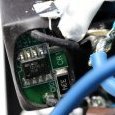Leaderboard
Popular Content
Showing content with the highest reputation on 09/11/18 in all areas
-
2 points
-
You are having problems with the flash drive, as you may have suspected. Put it in your PC and let it checkdisk. Also, try a different USB port, preferably USB2.2 points
-
So for example if you wanted to have a Movies share, and you had folders under that called Movies HD and Movies SD, then those would be at /mnt/user/Movies/Movies HD and /mnt/user/Movies/Movies SD. Then in your docker volume mappings, you would just use /mnt/user/Movies/Movies HD as the Host volume for the container volume /HD Movies, and as far as Plex is concerned, the HD Movies are exactly where they were before, in /HD Movies. And so on. If you understand volume mappings then you should be able to figure out the rest of it. Let me know if you need further explanation.1 point
-
I'll be honest, I would rather see the limited resource available spent on the product (i.e. unRAID e.g. fix bugs and add features) rather than trying to please the vocal few who can't deal with change. I think this set a precedence that things are done for whoever wins the "who screams the loudest" contest (with bonus points for the "who writes the vaguest complaint" award). #ProgressIsGood1 point
-
It is instant. Install Docker Container > Enter VPN credentials > Configure SABNZBDVPN Download Directories > Send a file > Monitor Download Set VPN_ENABLED = yes or no and compare the results. I use Sonarr and Radarr to send but any download should present these timeouts once SABNZBDVPN gets the job.1 point
-
CA blocks new installs of it (because its been deprecated). Only if you've previously had it installed will it allow you to reinstall. It just doesn't work quite right under latter versions of unRaid.1 point
-
FYI i have received an anonymous donation (thanks again), so i will be doing some further testing tonight. Please can somebody try and give me a step by step guide on how i can reproduce the timeouts, or at least give me some indication as to how long i will have to wait to see the issue if it's intermittent.1 point
-
No mater GPU (+-) / Keyboard (+-), does controller's AHCI BIOS post ? If YES, I want you try 1) OptROM xxx ( not exactly remember ) set "keep current setting" instead "force BIOS" 2) "PCIe storage boot" set disable ( in CSM section if CSM was enable ) After confirm no controller's AHCI BIOS post, then try GPU (-) and Controller (+) succes or not.1 point
-
1 point
-
This should be expect. Headless + Controller still have that short beep, but fail boot ........ anyway all my unRAID(s) never here longer beep once success boot up.1 point
-
A new cpu wont hurt, should be as simple as taking out the old, and putting in the new. (what socket are you running? 1151? 2011? 2011-v3? What mobo? I have to agree with the others here though first, ram is king, and you sir seem to be running short. 'Part' of the high cpu usage, could be the fact the system is moving and caching memory to make more space available, and this takes cpu cycles to accomplish.1 point
-
Does any boot sound hear or have set continue boot even error ?1 point
-
You can't isolate cpu in the flash config AND pin the same cpu cores to dockers. Your flash config says you isolated 2-5, 8-11. If you set Plex to use any of those 8 cores, it will just max out the first one (in this case core 2) and uses nothing else. Basically "unRAID" and "docker" are the same thing aka "the host". If you force the host to use something that is isolated from it (e.g. pin an isolated core on a docker), it will go into stupid mode. Solution: Change your Plex core pin to use non-isolated cores and/or change your flash config to exclude the cores that Plex uses1 point
-
To be more concise: A single subnet (ie 192.168.0.1/24) is identified by the gateway (ie 192.168.0.1) Docker will not allow you to have more than one NIC connected to a single subnet so once eth0 is configure to be on 192.168.0.1/24, you can no longer configure eth1 to be on the same subnet. If you need to have more interfaces due to concerns over bandwidth issues, you can opt to bond your interfaces together which should work most of the time (depending on actual switch support).1 point
-
I just started about a month ago and have been solving issues like finding the network folder and getting dockers set up. This project is really hitting a stride and the reason is because all my issues have been solved and run into before so far. I have gotten a lot of help and I am sure the old school helpful "nerds" are the ones who visit the lounge so Thank You! so very much. I am really loving the possibilities with unraid ahead.1 point
-
1 point
-
You need to add additional "Path". You click on "Add another Path, Port, Variable, Label or Device" in container settings. You can then map your external drive to a path inside the container.1 point
-
I have encountered Machine Check Exceptions "mce:" in the past and for me they have always been a failing ECC memory chip. Memtest says the memory is OK because as far as it is concerned, the memory is working as correct values are being written and verified, but the ECC hardware has had to correct the bits on the chip, raising an MCE exception that Memtest hasn't detected/isn't hooked into. I've have a machine that is currently generating MCE exceptions and if I run Windows on it, I can't tell it's happening but if I run Linux I can see then errors occasionally. They don't happen often as the machine has 256GB of ECC RAM so it's not often using the bit of ram that's 'iffy'. This has been my experience, although there could be other reasons MCE exceptions are being raised. 🤔1 point
-
Hi to everyone, sorry to take this topic abandoned, I decided 1 year ago to don't use anymore unraid(No snapshot support, Switched to glusterFS) and I Forgot to answer replies. Well I see pretty interest in this docker, I don't know the situation of Xpenology right now, it does support latest Synology versions? Now i'm going 2 weeks to japan, when I return I will try to take time to update and simplify the docker image.1 point
-
No, unRAID found my drives on my T310 with the H700, I just had to set them up individually as RAID 0. The configuration is not straightforward, but "do-able." After my experience, I would have gone with the H200 so that I could put it into an IT mode, but for now, I am fine with the H700.1 point
-
A few points about plex HW transcoding.. its buggy at best. I use it.. and I disabled it. AMD cards as of writing this, are still not 'supported'. That being said, enabling HW transcoding seems to offload 'some' work to amd gpu's. Nvidia cards work, but only 1 HW transcode unless you've got a high end CAD card(non consumer/gaming), they seem to be able to handle give or take 10 transcodes. Transcoding 'is multhreaded', however it still prefers IPC over threads. A single i9 7xxx, or thread ripper still smashes even quad socket mobo setups. Same goes for gpu's.1 point
-
I use this script to swicth VM from the desktop. I put the switchvm.sh file at the root of my flash drive, then, I use a .bat file to call putty : "C:\Program Files (x86)\PuTTY\plink.exe" -ssh -pw password root@tower "/boot/switchvm.sh VM-1 VM-2 > /dev/null &" You just need to change the user/password and the VM-1 VM-2 parameters switchvm.sh The script shuts down the first VM, waits for it to actually shut down, and the start the second VM.1 point
-
And just an extra thanks again to all commenting here. It's because of communities like this that I try and learn things I know little about.1 point
-
Really, really sorry to hear this. This was my personal nightmare a while ago. Not only was I concerned that an attack could come from my own machine but from any (Windows) machine on my network used by my family or guests. Since then I have done the following to prevent/reduce the likelihood of this happening (I hope): Not export any disks, only the shares I need to. Created a special user that is the only one allowed to write to the shares. Make all shares read-only with the exception for this special user (except a Public share folder writeable by everybody). Have my Backup program (Syncovery) perform the backups of my Windows machines with the special user rights. I trust that an attacker will not find the login information buried deep inside of the backup program. Syncovery has a randsomware detection that detects if data has changed massively in a directory and refuses to copy. When I need to perform small copy jobs I copy the data to the Public share, then telnet into unRaid and copy the data over to where I need it. On my Windows work machine, created a separate Windows user identical to the special user on unRaid. When I need to work on the array data I open a Windows session with the special user and refrain from any surfing. It's a bit of work but this way I am feeling confident that my data is safe from a randsomware attack. Independent of unRaid I am backing up my most important personal data with Crashplan which only writes changes and has versioning. I hope you will find a way to get your data back and that the description above helps you to secure you data for the future. All the best! Tazman1 point
-
I concur with @John_M, using "fill-up" is in my opinion always greater than "most-free", once a drive is filled use it as read-only. I'm the owner/developer of unBALANCE, and, in similar fashion to the "fill-up" philosophy, I believe that once you've filled up a drive, don't mess with it. I built unBALANCE because I sometimes failed to do that, probably being an unRAID rookie and all. I believe Freddie's diskmv was built on a similar idea. The thing is, to this day, I have separate folders for movies quality (xvid, dvd, blurip, bluray, uhd), so whenever I find a better version I delete a lesser one. That leaves empty gaps in the drive where the content was deleted, so I've used unBALANCE to figure out how to better allocate space for me. Also, I had tvshows season all over different disks, and whenever I binged, had to wait for spinup, which in retrospect, is it so bad ? Not sure, but millenials' timespan is like zero In any case, along the lines, other scenarios, such as converting filesystems (RFS to XFS), freeing a disk to do encryption came along, and made sense for unBALANCE. I believe the last frontier is in-place encryption .. once that happens, unBALANCE's usage (~4k+ per version), should go way down, I think.1 point








